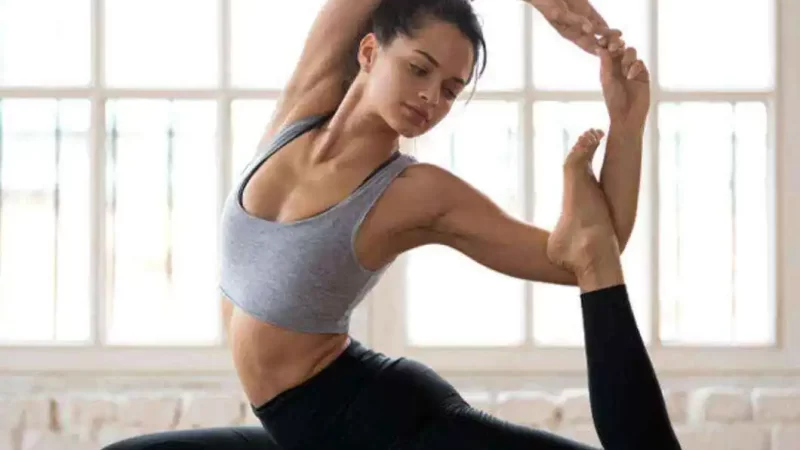A Beginner’s Guide Chair Yoga

Yoga is widely known for its ability to enhance flexibility, strength, and mental well-being. However, for many people, traditional yoga poses on a mat may be physically challenging due to mobility issues, injury, or aging. This is where chair yoga comes in—an accessible, gentle form of yoga that allows participants to perform modified poses while seated or using a chair for support.
Chair yoga retains the benefits of traditional yoga, but it is designed to accommodate people of all fitness levels and physical abilities. This beginner’s guide to chair yoga will introduce you to its benefits, key poses, and how you can start practicing today.
What is Chair Yoga?
Chair yoga adapts the poses used in traditional yoga to a seated position, making it more accessible for people who may struggle with balance, flexibility, or strength. This form of yoga is particularly popular among seniors, individuals with physical disabilities, and those who are recovering from injuries. However, it can be practiced by anyone seeking a gentler form of exercise that still offers the numerous physical and mental benefits of yoga.
In chair yoga, participants can perform many of the same postures as they would on a mat, including stretches, twists, bends, and even modified versions of standing poses. A chair is used as a stable base for balance and support, which reduces the risk of falling or overexerting the body.
Benefits of Chair Yoga
Chair yoga offers a range of benefits for both physical and mental health:
- Improved Flexibility and Strength: Chair yoga gently stretches muscles and joints, helping to increase flexibility over time. The strength gained from chair yoga can improve daily functioning and reduce the risk of injury. Care homes like the one found at hambleheightscarehome.co.uk often encourage their residents to take part in chair yoga sessions to improve their strength and mobility, as well as to have fun.
- Enhanced Balance and Coordination: Many chair yoga poses focus on balance, which is especially important for seniors. Improving balance helps reduce the risk of falls, a common concern among older adults.
- Reduced Stress and Anxiety: Like traditional yoga, chair yoga incorporates deep breathing techniques and mindfulness, which can help calm the nervous system, reduce stress, and improve mental clarity.
- Better Posture: Chair yoga encourages proper alignment and core engagement, helping to correct posture and alleviate tension in the neck, back, and shoulders.
- Joint and Pain Relief: By gently moving through a range of motion, chair yoga can help alleviate stiffness in the joints and improve circulation, which is especially beneficial for individuals with arthritis or other joint-related conditions.
- Increased Circulation: The gentle movements and stretches of chair yoga promote better blood flow, which can aid in overall health and energy levels.
Basic Chair Yoga Poses
Chair yoga incorporates modified versions of traditional yoga poses, using the chair for support. Here are a few beginner-friendly poses to try:
- Seated Mountain Pose: Sit tall with your feet flat on the ground and hands resting on your knees. Engageyour core, relax your shoulders, and lengthen your spine. This pose helps with posture and core strength.
- Seated Cat-Cow: With your hands on your knees, alternate between arching your back (cow pose) and rounding it (cat pose), inhaling as you arch and exhaling as you round. This pose helps stretch the spine and relieve tension in the back.
- Seated Forward Bend: Sitting at the edge of your chair, slowly bend forward, reaching your hands toward your feet. This gentle stretch increases flexibility in the lower back and hamstrings.
- Seated Twist: Place one hand on the opposite knee and the other hand on the back of the chair. Slowly twist your torso, looking over your shoulder, and repeat on the other side. Twists improve flexibility in the spine and aid digestion.
- Seated Warrior I: From a seated position, extend one leg behind you and keep the other bent at a 90-degree angle. Raise your arms above your head, engaging your core. This pose strengthens the legs and stretches the hips.
Getting Started with Chair Yoga
Chair yoga is a great option for those looking to gently increase their flexibility, balance, and strength without the demands of traditional yoga. To start practicing:
- Choose a sturdy chair: A chair with no wheels or armrests is best for stability. Ensure it is at a comfortable height with enough room around you to move freely.
- Wear comfortable clothing: Loose or stretchy clothing will allow for a greater range of motion.
- Focus on breathing: As with traditional yoga, breathwork is a core element of chair yoga. Inhale and exhale deeply to enhance relaxation and focus.
- Move at your own pace: There’s no need to rush through the poses. Listen to your body and only move within your comfort zone.
Conclusion
Chair yoga is an inclusive, accessible form of exercise that offers numerous physical and mental health benefits. Whether you’re new to yoga or looking for a gentler practice, chair yoga allows you to experience the benefits of yoga in a safe, supportive way.
By practicing regularly, you can improve your flexibility, strength, and overall well-being—all from the comfort of a chair.

